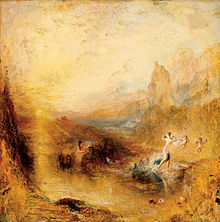Colorism (painting)

As colourism (from the Latin "color" = color), a design way in painting is called, in which the color is given a special meaning.
It emerges from the drawing and thus other means of painting - such as line, composition or perspective. The use of color serves to stimulate the senses, the image should develop its effect through the color, not the form. Coloristic works are often colorful, but often also flat and sometimes striking. The colorism cannot be assigned to a specific epoch of painting, so examples of coloristic images can be found in the Venetian painting of the Cinquecento or the ceiling painting in the Baroque . The choice of color dominance over graphic design was particularly widespread among the impressionists . Colorism approaches can also be found in abstract and wild painting . Individual painters of an era or region who saw themselves connected to colorism are now referred to as colorists.

literature
- Erich von der Bercken: About some basic problems in the history of colorism in painting. In: Munich Yearbook of Fine Arts. NF 5, 1928, ISSN 0077-1899 , pp. 311-326.
- Dušan Brozman: O barvě. Český kolorismus od Slavíčka po současnost. = On color. The Czech colorism from Slavíček to the present. Moravská galerie, Brno 2009, ISBN 978-80-7027-204-6 (exhibition catalog, Brno, Moravská galerie v Brně, 6 November 2009 - 31 January 2010).
- Andreas Prater: The colors of salvation. On the importance of Michelangelo's colorism in the Sistine frescoes. In: Belvedere. 1, 1999, ISSN 1025-2223 , pp. 32-49.
- AL Plehn: Modern colorism and its accusers. In: The art. 1, 1900, ZDB ID 501102-4 , pp. 243-248.
Individual evidence
- ↑ a b according to Definition in the large art dictionary by PW Hartmann
- ↑ according to HW Georg Georgus, colorism in painting on Malerei-Technik.de